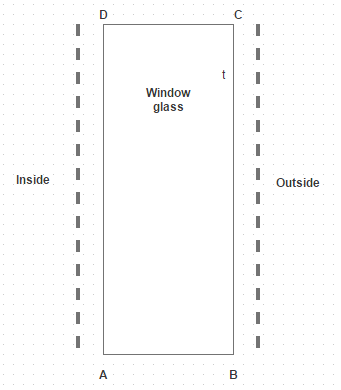This set of Heat Transfer Multiple Choice Questions & Answers (MCQs) focuses on “Heat Generation Through Plane Wall”.
1. In case of heat conduction through the plane wall, which one of the following is not a correct assumption?
a) Steady state
b) Three dimensional heat flow
c) Volumetric heat generation must be constant
d) K must be constant
View Answer
Explanation: There should be two dimensional heat flow. The differential equation describing the temperature distribution can be set up by making an energy balance.
2. If Q X is heat generated in at distance ‘x’, then heat conducted out at a distance (x + d x) will be
a) Q X + 3d (Q X) d x /d x
b) 2Q X + d (Q X) d x /d x
c) d (Q X) d x /d x
d) Q X + d (Q X) d x /d x
View Answer
Explanation: Q X + Q g = Q X + d X.
3. Notable example of uniform generation of heat within the conducting medium are
(i) Energy of a nuclear reactor
(ii) Liberation of energy due to some exothermic chemical reactions
(iii) Resistance heating in electrical appliances
Which of the statements made above are correct?
a) i, ii and iii
b) i and ii
c) i and iii
d) Only ii
View Answer
Explanation: All the statements are correct with respect to plane wall heat conduction.
4. For a plane wall of thickness l with uniformly distributed heat generation q g per unit volume, the temperature t 0 at mid plane is given by
a) t 0 = q g l 2/2k +t w
b) t 0 = q g l 2/4k +t w
c) t 0 = q g l 2/8k +t w
d) t 0 = q g l 2/16k +t w
View Answer
Explanation: t = q g /2k (l – x) x + t w. At mid plane i.e. x = l/2 we get t 0 = q g l 2/8k +t w.
5. The temperature drop in a plane wall with uniformly distributed heat generation can be decreased by reducing
a) Wall thickness
b) Heat generation rate
c) Thermal conductivity
d) Surface area
View Answer
Explanation: On decreasing wall thickness, generally temperature drop decreases.
6. Consider a slab of thickness δ with one side (x = 0) insulated and other side (x = δ) maintained at constant temperature. The rate of uniform heat generation within the slab is q g W/m3. Presuming that the heat conduction is in steady state and one dimensional along x direction, the maximum temperature in the slab would occur at x equal
a) δ/2
b) Zero
c) δ/4
d) δ
View Answer
Explanation: Maximum temperature occurs at the insulated face of the wall where x = 0.
7. There occurs heat conduction and internal heat generation at uniform rate within the conduction medium itself in the following cases
(i) Drying of concrete
(ii) Chemical processes
(iii) Fuel elements in a nuclear reaction
Choose the correct option
a) i only
b) ii only
c) i and iii
d) i, ii and iii
View Answer
Explanation: All are correct as there is heat conduction in all above cases. The rate of heat generation has to be controlled one, otherwise the resulting temperature growth might result in the failure of the medium.
8. The rear window of an automobile is made of thick glass i.e. AB = 5 mm and thermal conductivity is 0.8 W/m degree. To defrost this window, a thin transparent film type heating element has been fixed to its inner surface. For the conditions given below, determine the electric power that must be provided per unit area of window if a temperature 5 degree Celsius is maintained at its outer surface. Interior air temperature and the corresponding surface coefficient are 20 degree Celsius and 12 W/m2 degree. Surrounding air temperature and the corresponding surface coefficient are – 15 degree Celsius and 70 W/m2 degree. Electric heater provides uniform heat flux

a) 232.5 /m2
b) 1232.5 /m2
c) 2232.5 /m2
d) 3232.5 /m2
View Answer
Explanation: (t I – t f)/(1/h i + δ/k) + q g = h 0 (t s – t 0).
9. Suppose heat is conducted due to electrons
Where, i = I/A and p is the resistivity, then
a) q g = 2i2 p
b) q g = 3i2 p
c) q g = i2 p
d) q g = 4i2 p
View Answer
Explanation: It should be i2 p. Here i is current density.
10. In case when both the surfaces of plane wall are at different temperature, we get an expression i.e.
T MAX – T W2 /T W1 – TW2 = (B + 1)2/4B
What is the value of B?
a) (q g) (δ)2/2k (T W1 – TW2)
b) (q g) (δ)3/3k (T W1 – TW2)
c) (q g) (δ)4/4k (T W1 – TW2)
d) (q g) (δ)5/5k (T W1 – TW2)
View Answer
Explanation: T – T W2 /T W1 – TW2 = [1 – x/ δ] [B x/ δ +1].
Sanfoundry Global Education & Learning Series – Heat Transfer.
To practice all areas of Heat Transfer, here is complete set of 1000+ Multiple Choice Questions and Answers.
If you find a mistake in question / option / answer, kindly take a screenshot and email to [email protected]
- Check Chemical Engineering Books
- Practice Chemical Engineering MCQs
- Apply for Chemical Engineering Internship
- Check Heat Transfer Books
- Apply for Mechanical Engineering Internship
